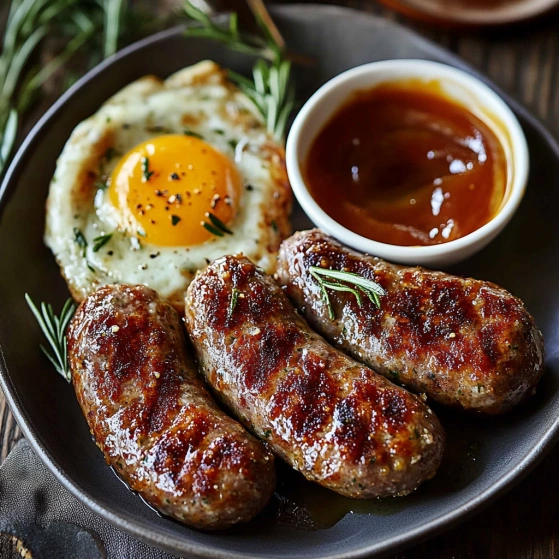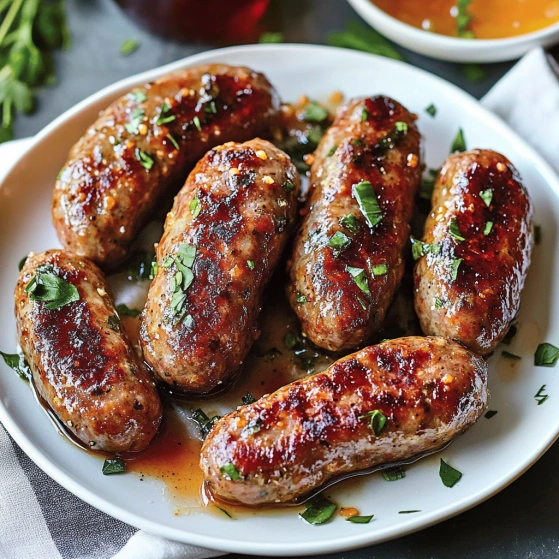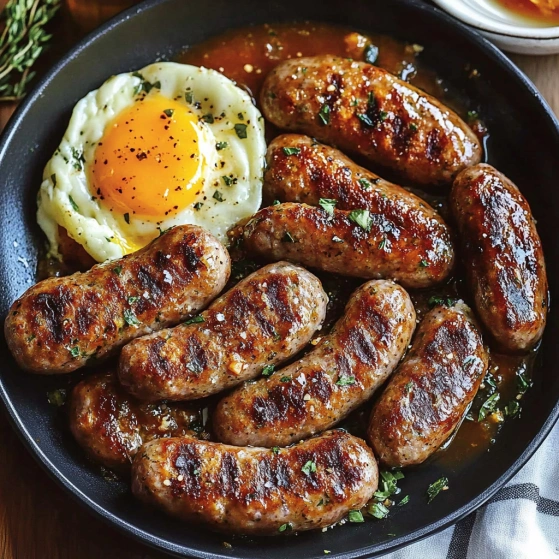 Pin it
Pin it
This homemade sausage recipe transforms ordinary ground pork into restaurant-quality breakfast patties with minimal effort. I discovered this technique after growing tired of store-bought options with their mysterious ingredients and excessive salt. Now my weekend brunches have reached an entirely new level of flavor.
I first created this recipe when hosting a holiday brunch gathering where I needed to accommodate various dietary preferences. The crowd's reaction convinced me to make these sausages part of my regular cooking rotation, and they've become my signature breakfast item.
Ingredients
- Pork shoulder: Provides the ideal fat content for juicy, flavorful sausage patties
- Fresh sage: Delivers that classic breakfast sausage flavor that dried herbs simply cannot match
- Fresh thyme: Adds earthy notes that complement the sage beautifully
- Red pepper flakes: Contribute a gentle heat that builds rather than overwhelms
- Paprika: Offers a subtle smoky quality and gorgeous color
- Nutmeg: Might seem unexpected but adds wonderful warmth and depth
- Garlic cloves: Intensify the savory profile without dominating
- Brown sugar: Balances the heat and helps achieve beautiful caramelization
- Coarse salt: Enhances all flavors and helps preserve the meat
- Black pepper: Provides essential background heat
- Cooking oil: With a high smoke point allows proper browning without burning
Step-by-Step Instructions
- Prepare the Meat:
- If using pork shoulder instead of pre-ground pork, cut it into 1-inch chunks and place in the freezer for 15-20 minutes until firm but not frozen. This makes grinding much easier and produces a better texture. Process through a meat grinder with a medium die for the perfect consistency. If using pre-ground pork, ensure it has a good fat content, preferably around 20-30%.
- Create the Flavor Base:
- Place ground pork in a large bowl and add all seasonings. Use your hands to gently but thoroughly incorporate the herbs, spices, garlic, sugar, salt and pepper. Work quickly but avoid overworking the meat, which can make the sausage tough. The mixture should look evenly speckled with herbs.
- Taste Test:
- Form a small patty about the size of a silver dollar and cook it in a hot skillet for about a minute per side. This crucial step allows you to adjust seasonings before committing to the entire batch. Need more heat? Add pepper flakes. Too spicy? Add a pinch more brown sugar to balance.
- Form the Patties:
- With slightly wet hands to prevent sticking, portion the mixture into 2½-3 inch patties of even thickness. Press a slight dimple in the center of each patty with your thumb to prevent puffing during cooking. For consistent sizing, consider using a kitchen scale to measure approximately 2 ounces per patty.
- Cook to Perfection:
- Heat oil in a heavy skillet over medium heat until shimmering but not smoking. Carefully place patties in the pan, being careful not to overcrowd. Cook for 3-4 minutes per side until deeply golden brown and the internal temperature reaches 160°F. The patties should have a beautiful crust while remaining juicy inside.
 Pin it
Pin it
The fresh sage in this recipe completely transforms the flavor profile. I grow sage in my garden specifically for this recipe, having learned that nothing compares to the aromatic oils released when you mince fresh herbs just before mixing. During the holidays, I sometimes add dried cranberries to the mixture, creating a festive variation that pairs beautifully with pancakes.
Storage Solutions
Uncooked sausage patties can be stored between layers of parchment paper in an airtight container for up to 3 days in the refrigerator. For longer storage, freeze the raw patties on a baking sheet until solid, then transfer to freezer bags with parchment between layers. They can be cooked directly from frozen, just add 2-3 minutes to the cooking time per side. Cooked sausages will keep in the refrigerator for up to 4 days and can be quickly reheated in a skillet with a splash of water to maintain moisture.
 Pin it
Pin it
Versatile Variations
The basic recipe serves as an excellent foundation for countless variations. For an Italian twist, substitute the sage and thyme with fennel seeds and oregano. Maple breakfast sausage can be created by replacing the brown sugar with real maple syrup and adding a pinch of cinnamon. Chicken or turkey can replace pork for a leaner option, though you'll need to add 1-2 tablespoons of olive oil to compensate for the reduced fat content. For a unique summer sausage, add minced apples and a touch of rosemary to the base recipe.
Serving Suggestions
While these sausages shine as part of a traditional breakfast alongside eggs and toast, their culinary potential extends much further. Crumble the uncooked mixture and brown it for an exceptional pasta sauce or pizza topping. Form smaller patties to create sliders paired with caramelized onions and whole grain mustard. For an elevated brunch, serve alongside roasted sweet potatoes and a poached egg with hollandaise. The patties also freeze beautifully between layers of parchment paper, providing a quick protein option on busy mornings.
Frequently Asked Questions
- → Can I use pre-ground pork instead of grinding pork shoulder?
Yes, pre-ground pork works perfectly well. The recipe allows for either option, though grinding your own pork shoulder gives you more control over the fat content and texture.
- → How can I store leftover homemade sausage?
Cooked sausage patties can be refrigerated for up to 3 days in an airtight container. They can also be frozen for up to 3 months. Reheat thoroughly before serving.
- → Can I make these sausages ahead of time?
Yes! You can mix the meat and seasonings and form the patties up to 24 hours in advance. Keep them covered in the refrigerator until you're ready to cook them.
- → Can I adjust the spice level?
Absolutely. The red pepper flakes determine the heat level, so you can reduce or increase the amount based on your preference. The test patty step is perfect for adjusting all seasonings to taste.
- → What can I serve with homemade sausage?
These sausage patties pair wonderfully with eggs, toast, and potatoes for breakfast. They also make great additions to pasta dishes, sandwiches, or grain bowls for lunch or dinner.
- → Can I use dried herbs instead of fresh?
Yes, but reduce the amount to about 1 teaspoon each of dried sage and thyme, as dried herbs are more concentrated than fresh ones.
